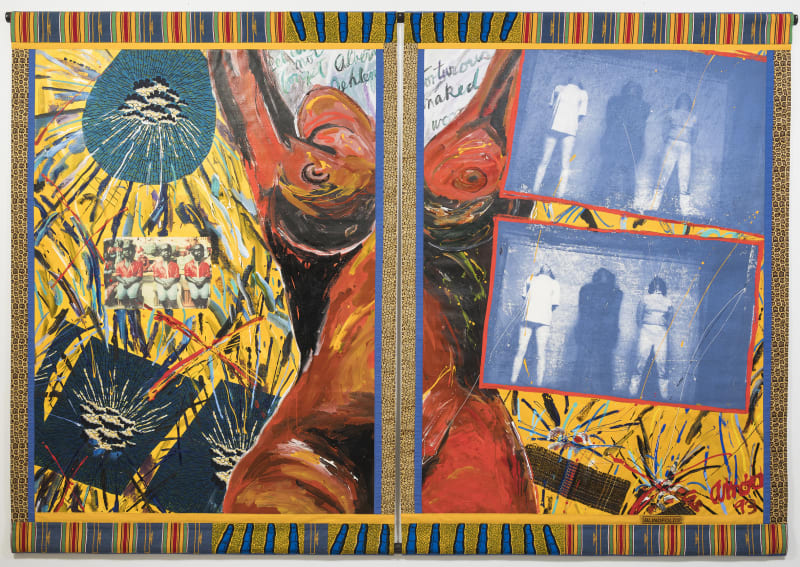Pippy Houldsworth Gallery is delighted to present ‘My Kind of Protest’, an exhibition of works by Emma Amos, Vivian Browne and Chemu Ng’ok. Working across different time periods, each of these artists creates psychologically charged portraits addressing what it means to be a black woman in a society ruled by men. While some of these works date back 60 years, they remain no less relevant in today’s fraught political climate and the three artists share a common, still unresolved and pertinent struggle. This intergenerational exhibition will comprise a rare 1960s oil painting from Vivian Browne’s first major body of work, important historical works by Emma Amos from the 1980s and 1990s, and new paintings by young Kenyan artist Chemu Ng’ok.
Chemu Ng’ok, born in 1989, came to prominence as part of the 2018 Triennial at the New Museum in New York. For this exhibition, she will show a series of new work which addresses the visual iconography of power. Stemming from the political tension and violence surrounding the 2017 Kenyan elections, these works suggest the changes in the landscape as the army begins to patrol the streets. Ng'ok addresses the effect on civilians of this physical manifestation of power. The characters’ internal struggle is made visible by the intentionally unsteady hand. The figures, some clearly outlined and others mere shadows, chaotically inhabit the canvas as if constantly in flux, underlining the moment when an internal psychological state translates into the collective body. It is their dreamlike and ghostly quality that makes Ng’ok's works so powerful, at once anchored within a poignant political situation and echoing parallel global unrest. Grappling with narratives of power, personal and political, Ng’ok depicts the contemporary reality of post-colonial society.
Emma Amos, born in the US in 1937, co-opts portraiture as a way of empowering African Americans so rarely depicted in the history of art. It is only following the Black is Beautiful movement in the 1960s that she felt able to use the black body within her work, often using herself as the model. She seeks to disrupt the preconceived notions of art ‘who makes it, poses for it, shows it and buys it.’ Josephine and the Mountain Gorillas, a unique example of work which incorporates Amos' own intricate weaving practice, is both a portrait of Josephine Baker with her pet gorillas and a social commentary on the exoticisation of the black figure. Blindfolds (after Albert Oehlen) critiques her male contemporaries disregard for the female model and the difficulty for women artists to gain commercial and critical success. X-Ray Showing Norman Lewis incorporates her signature X painted across the canvas, highlighting the perceived insignificance of her work as a black female artist. Amos and Browne were contemporaries working within the same community; and Amos was the sole female member of Spiral, a collective founded in the 1960s by Charles Alston, Romare Bearden and Norman Lewis to address the power and possibilities of art within the civil rights movement.
Arising out of the civil rights movement, American artist Vivian Browne’s series Little Men takes a political stance by belittling and mocking the patriarchy - laying bare their vulnerabilities. As explained by Lucy Lippard, Browne’s work ‘casts a jaundiced eye on the rich, the white and the male, ironically rendered in soft focus as though their very real power were in fact an illusion.’ By figuratively disempowering her subjects, making the figures both human and repulsive, she opens up a space for others to inhabit this position but also performs a personal catharsis. Referencing James Baldwin, Browne says she needed to vomit these men as a way of releasing herself. Browne was deeply involved with both feminism and politics throughout the 1960s and 1970s, and was an active member of the Black Emergency Cultural Coalition, the Women’s Caucus for Art and Where We At, a women’s collective established by a group of artists including Faith Ringgold.
Emma Amos’ (b. 1937 Atlanta, GA) work is currently on view at the Whitney Museum of American Art and was recently included in the British Museum’s ‘American Dream’, Tate Modern’s ‘Soul of a Nation: Art in the Age of Black Power’ and the Brooklyn Museum’s ‘We Wanted A Revolution: Black Radical Women, 1965-85’. In 2016, she was honoured by the Studio Museum in Harlem as an Icon and Trailblazer, along with Faith Ringgold and Lorraine O’Grady. In 2020, Amos will be the subject of a retrospective exhibition at Georgia Museum of Art in Athens, Georgia. Public collections include the British Museum, London; Bronx Museum of Art, New York; Fowler Museum of Art, Los Angeles; Metropolitan Museum of Art, New York; Museum of Modern Art, New York; Studio Museum in Harlem, New York; Whitney Museum of American Art, New York; Philadelphia Museum of Art, Philadelphia and National Gallery of Art, Washington D.C. amongst others.
Vivian Browne (1929 Laurel, FL - 1993 New York, NY) was also recently included in the 2017 Brooklyn Museum exhibition ‘We Wanted a Revolution: Black Radical Women 1965-85’, which travelled to the Albright- Knox Art Gallery, Buffalo and the Institute of Contemporary Art, Boston (2017-2018). She received numerous awards throughout her life, including a MacDowell Colony Fellowship. In 1986, Mayor Ed Koch of New York City honored her for her achievements in the arts, and in 1990, she served as a Fulbright Panelist. Public collections include the Museum of Modern Art, New York; Smithsonian American Art Museum, Washington D.C.; Hatch-Billops Collection, Emory University, Atlanta; Schomburg Center for Research in Black Culture, New York and Wadsworth Atheneum, Hartford, CT.
Chemu Ng’ok (b. 1989, Nairobi, Kenya) received her MFA from Rhodes University, Grahamstown, South Africa in 2017. In September, she will participate in the Fountainhead Residency in Miami. She was awarded the Masters Bursary in 2015 as part of the Mellon Foundation’s Visual and Performing Arts of Africa Research Focus Group. Exhibitions include the New Museum, New York, (2018); National Gallery of Zimbabwe, Harare, Zimbabwe (2017); Rhodes University, Grahamstown, South Africa (2014).
